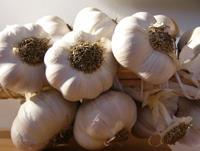Garlic extract offers an innovative treatment for patients with advanced gum disease, report UK researchers.
Garlic extract offers an innovative treatment for patients with advanced gum disease, report UK researchers.

Although general antibacterial properties are known, this is the first time garlic has been studied against oral bacteria. The active component, allicin, is formed when garlic is crushed. The allicin works by inactivating enzymes essential for bacterial growth.
Periodontitis, a severe form of gum disease that can result in tooth loss, is often treated with common antibiotics such as amoxicillin, but antibiotic resistance is a growing problem. Finding effective cures that are less likely to induce resistance is important.
Ian Douglas at the University of Sheffield’s school of dentistry, predicts that resistance to allicin would develop relatively slowly. This is because allicin works against the enzymes needed for bacterial growth and not against the bacteria itself, he said. The agent is not present in raw garlic, but is formed rapidly by the action of allinase on the precursor once the clove is crushed.
The extract tested contained 220?g/ml of allicin - equivalent to three garlic bulbs. The extract was highly effective against many oral pathogens, suggesting that garlic extract could be of therapeutic use, says Douglas. However, he cautions, there are around 700 species of bacteria associated with periodontitis.
Although the current results are promising, Douglas and colleagues are already looking to overcome limitations. Allicin is unstable, so a method of stabilising it is needed before it can be fully tested in an animal model. And that’s not the only drawback. ’Unfortunately, allicin does smell and the "garlic breath" is an issue yet to be resolved,’ Douglas conceded. Vikki Allen
References
I M Bakri and C W I Douglas, Archives of Oral Biology2005, 50, 645






No comments yet